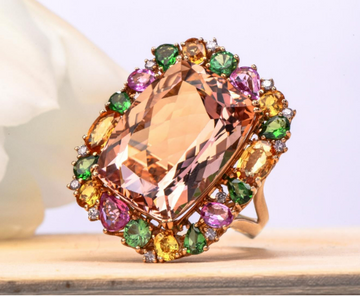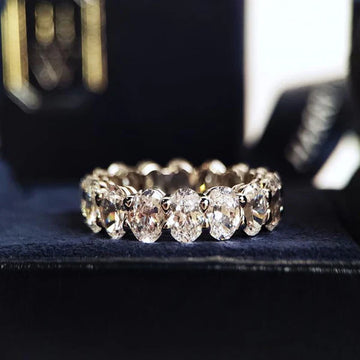Rings have been cherished by civilizations for thousands of years. From ancient Egypt to modern-day fashion runways, rings continue to serve as symbols of love, power, and personal expression. Whether it’s a wedding band, a statement piece, or a piece of art that reflects an individual’s personality, rings are as diverse as the people who wear them. In this ultimate guide, we will dive into the history, types, trends, and expert advice on how to choose the perfect ring for every occasion.
The Fascinating History of Rings?

Rings have an ancient history that dates back thousands of years, and their symbolism has evolved dramatically over time.
Ancient Beginnings:
The earliest rings were made of simple materials like bone, ivory, or leather. They were often worn by ancient Egyptians, who believed rings had magical properties. The circular shape symbolized eternity, while the materials, like precious stones and metals, were thought to have protective or healing powers. As metallurgy advanced, Egyptians began creating rings from gold and silver.
Roman Influence:
In ancient Rome, rings evolved into symbols of status and authority. The wealthy and powerful wore ornate rings, sometimes signifying their social rank. The use of rings as symbols of authority continued into the Middle Ages, with kings, queens, and bishops all wearing rings as a mark of power.
Renaissance to Modern Era:
By the Renaissance, rings became more personal. People began wearing rings with engraved family crests, gemstones, and intricate designs. The symbolic meaning of rings expanded, and they were used in various forms of communication, from betrothal rings to signet rings.
The Wedding Ring Tradition:
Arguably the most iconic and enduring symbol of rings is the wedding ring. The tradition of exchanging wedding rings dates back to ancient Egypt, but it was the Romans who formalized the practice. The idea of placing a ring on the fourth finger of the left hand, which was believed to have a vein directly connected to the heart (the "vena amoris"), became widespread.
Today, the tradition of wedding rings continues, and many cultures incorporate unique symbols and gemstones to represent their union.
Types of Rings: Understanding the Basics?

Rings are available in a wide array of styles, materials, and designs. Here are some of the most common types of rings:
1. Engagement Rings
An engagement ring is typically given during a marriage proposal and is a symbol of commitment. It is usually adorned with a diamond or other precious gemstone. The design of engagement rings has evolved over the years, from classic solitaires to elaborate multi-stone settings.
2. Wedding Rings
While engagement rings signify the commitment to marriage, wedding rings are exchanged during the wedding ceremony itself. Wedding bands are often simpler than engagement rings, though many people opt for matching sets of both.
3. Cocktail Rings
Cocktail rings are bold and often extravagant pieces of jewelry that are typically worn at formal gatherings or parties. These rings feature large gemstones, intricate designs, and a high level of craftsmanship. Cocktail rings were especially popular during the early 20th century, but they continue to be a staple for those looking to make a fashion statement.
4. Signet Rings
Signet rings are traditionally engraved with a family crest, initials, or other personal symbols. Once used as a seal to sign documents, these rings are now more of a personal accessory. They remain popular among those seeking a classic, masculine style or a meaningful family heirloom.
5. Stackable Rings
Stackable rings are multiple rings worn together on the same finger. These rings can be simple bands, or they may feature different gemstones and designs. The stacking trend allows for personal customization, making it easy to create a unique look that suits your individual style.
6. Promise Rings
Promise rings are exchanged between couples as a symbol of a commitment to one another. They may be given before an engagement to signify that the couple is serious about their relationship. Promise rings can also represent personal promises, such as loyalty, friendship, or self-love.
7. Birthstone Rings
Birthstone rings are rings set with the gemstone corresponding to the wearer’s birth month. These rings are often given as gifts and hold personal significance. Many people wear their birthstone ring as a reminder of their identity or to bring good luck.
8. Mood Rings
Mood rings were a popular fad in the 1970s, with color-changing gemstones that supposedly reflected the wearer’s emotions. While the science behind mood rings is more about temperature changes, they remain a fun, nostalgic item for many people.
Materials Used in Rings: Choosing the Right One?

The material used in a ring significantly impacts its appearance, durability, and price. Below are some of the most popular materials used in ring-making:
1. Gold
Gold is perhaps the most traditional and enduring material for rings. Available in a variety of colors—yellow, white, and rose gold—gold rings are prized for their beauty and timeless appeal. The purity of gold is measured in karats, with 24K gold being the purest form. However, gold is soft, so it is often alloyed with other metals like copper or silver to increase its durability.
2. Silver
Silver rings are often more affordable than gold but offer a similar elegant appearance. Sterling silver (92.5% silver) is the most common type used in ring-making. Silver can tarnish over time, so it requires regular cleaning and care.
3. Platinum
Platinum is a rare and precious metal that is more durable and heavier than gold. It is a popular choice for engagement rings due to its longevity and resistance to wear and tear. Platinum rings are typically more expensive than gold but offer a luxurious, long-lasting alternative.
4. Titanium
Titanium rings are known for their strength and lightness. They are incredibly durable, resistant to scratches, and hypoallergenic, making them an excellent choice for people with sensitive skin. Titanium is a popular choice for men’s wedding bands due to its rugged appeal.
5. Stainless Steel
Stainless steel rings are affordable, durable, and resistant to corrosion. They offer a modern, sleek look and are often used in contemporary designs. Stainless steel is also low-maintenance and can be polished to a high shine.
6. Alternative Metals and Materials
Other materials, such as tungsten, cobalt, and ceramic, are increasingly popular for rings due to their unique aesthetic and high durability. These materials are particularly favored for men’s rings, where the emphasis is often on strength and toughness.
7. Gemstones
Many rings feature gemstones, whether as a central stone or accent stones. Diamonds are the most famous gemstone for engagement rings, but other precious stones like sapphires, emeralds, and rubies are also highly sought after. Semi-precious stones, including amethyst, topaz, and garnet, are often used in cocktail rings and fashion jewelry.
Ring Trends: What's In and What's Out
Rings are more than just timeless symbols; they’re also an ever-evolving fashion accessory. Here are some current trends in the world of rings:
1. Sustainable and Ethical Jewelry
As consumers become more conscious of the environmental impact of mining and production, there is a growing demand for sustainable and ethically sourced rings. Lab-grown diamonds, recycled metals, and responsibly mined gemstones are increasingly popular choices.
2. Vintage and Antique Rings
Vintage and antique rings are making a comeback, with many people opting for unique, one-of-a-kind pieces. These rings often feature intricate designs and historical significance, making them a meaningful alternative to mass-produced jewelry.
3. Custom and Personalized Rings
Customization is a major trend in ring design, allowing individuals to create pieces that reflect their unique style and personality. From engraving names or dates to choosing specific gemstones, personalized rings are growing in popularity as a way to mark significant life events.
4. Minimalist Rings
Minimalism continues to dominate in many aspects of design, including rings. Simple, sleek bands in gold or platinum are highly sought after for engagement rings, wedding bands, and everyday wear. These understated designs are often paired with smaller, delicate gemstones for a refined look.
5. Bold Statement Rings
On the other end of the spectrum, bold, oversized rings are gaining popularity. These statement rings are often large and feature intricate designs, gemstones, or enamel work. People are increasingly using rings as a way to express their personal style and individuality.
How to Choose the Perfect Ring: Expert Tips?

Choosing the perfect ring involves more than just picking a design you like—it’s about finding a piece that fits your lifestyle, budget, and personal taste. Here are some expert tips to help guide you:
1. Consider Your Lifestyle
If you lead an active lifestyle, you may want to choose a durable material like titanium or platinum. For those who prefer minimal maintenance, sterling silver or stainless steel might be the best option.
2. Know Your Budget
Rings come in a wide range of prices, from affordable fashion rings to luxury pieces. Set a budget before you start shopping to avoid overspending. Remember that the cost of a ring will vary based on factors like material, gemstones, and craftsmanship.
3. Choose a Design That Reflects Your Personality
Rings are a form of self-expression. Whether you prefer classic, modern, or eclectic styles, your ring should reflect your taste. If you’re uncertain, start with something simple and elegant, and you can always add more pieces to your collection later.
4. Think About the Occasion
The occasion for which you're buying the ring will influence your choice. An engagement ring might warrant a traditional solitaire diamond, while a birthday gift could be a more personalized, colorful piece. Consider the recipient’s style and preferences.
Conclusion:
Rings are more than just adornments; they are symbols of love, commitment, status, and personal expression. From engagement rings to statement pieces, rings have the power to mark life’s most meaningful moments. By understanding the history, types, materials, trends, and expert tips, you’ll be well-equipped to choose the perfect ring for any occasion. Whether you’re buying for yourself or someone special, the right ring can create a lasting impression and stand the test of time!





